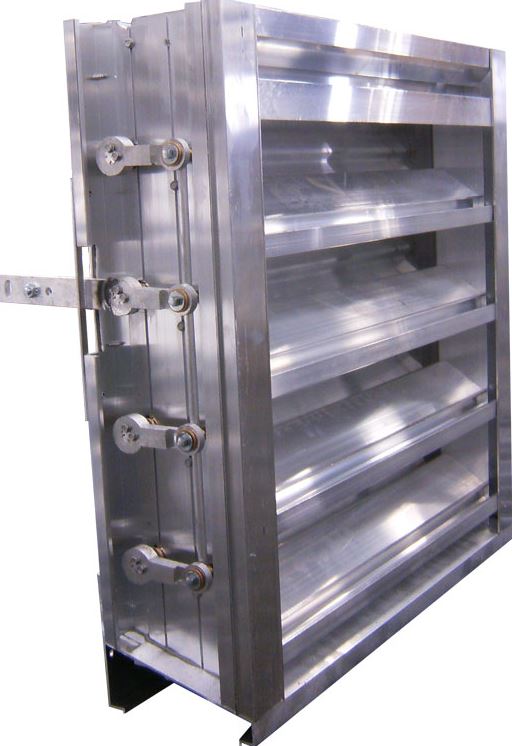Louvers are a critical ventilation component for an industrial ventilation system. They allow air to pass through them while keeping out unwanted elements such as water, dirt and debris when fitted with filters. Selecting the right louver for an application requires knowing how to navigate through all of the options and then sizing it properly to provide the required air flow. In this week’s blog, I share some of the louver selection tips that we use.
Material
Industrial louvers are mostly made from either aluminum or galvanized steel although some extreme applications may require stainless steel. Aluminum has the advantage of being easier to form so aluminum louver blades tend to have better designs for water resistance. Louvers made of aluminum are also lighter and provide better corrosion resistance. Aluminum can be painted with any color or can come with an anodized finish. For all of these reasons, we prefer to use aluminum.
Depth
The common depths for industrial louvers are 4 and 6 inches. The main advantage of the 6” depth is that it has more free area which means a lower pressure drop at any velocity. Another advantage is that it has a higher water penetration velocity. One of our louver selection tips is that unless there is a restriction on louver depth, we prefer to use the deeper option.
Drainable Blades
A drainable louver blade has a gutter designed to catch water that is separated from the air stream. The gutters lead to special channels in the louver’s jambs that drain the excess water down the sides of the louver and out the sill. The advantage of a drainable blade is that it provides more protection against water coming down the front of the louver and being sucked back in through the louver on lower blades. We always assume that water penetration is not desired, so we prefer to use drainable blades.
Fixed or Adjustable Blades
Although louvers are mostly thought of to have fixed blades, there are options with adjustable blades. The advantage of a adjustable blade louver is that it can be completely closed to prevent water penetration during sever weather or to keep in heat during the winter. The downside to moveable blade louvers is that they cost more. Another one of our louver selection tips is that unless adjustable blades are specified by the customer, we prefer the fixed blade louvers.
Acoustic Louvers
The blades of an acoustic louver are made with a layer of sound absorbent material. There are also different blade types that can provide additional sound attenuation by providing complete line of sight blockage. The down sides to acoustic louvers are increased air resistance and the additional cost. We prefer to use acoustic louvers only when there is a specific noise requirement that must be met.
Sizing
The art of sizing a louver starts with determining the desired air velocity through the louver. A higher air velocity has a higher risk of water penetration which most often starts at 1,000 (we need to look at this) ft/min. A lower air velocity causes less resistance so there is a lower static pressure drop. We prefer to size louvers that have static pressure drops under 0.15 in. w.g. Keeping the air velocity through the louver in the range of 700 to 900 ft/min yields both a lower risk of water penetration and a lower pressure drop.
Once the air velocity is selected, divide the required air flow, in CFM, by the air velocity to determine the amount of free area, in sq. ft., that will be need in the louver. Now divide the amount of free area by the percentage of free area for the style of louver that has been selected. The result will be the total area of the louver that is need.
The next step in sizing a louver is to look at the dimensional chart provided by the manufacture to find a size based on height and width that comes closest to providing the total louver area that is needed. Based on the height and width limitations, the louver may need to be sized with two or more panels.
The final step is to determine if the louver will fit in the desired location. If not, the air velocity can be increased to decrease the total area of the louver but this will increase the pressure drop of the louver based on how much the area is reduced.
Conclusion
At Eldridge, our 75 years of experience has made us experts at designing and selecting the right louver for every application. Based on the needs of our marine customers, we designed the Eldridge Vertical Storm Louver for use in our patented Eldridge Storm Guard Hoods. The 6” version of the Eldridge Vertical Storm Louver can withstand rain falling at a rate of 14” per hour with a 50 MPH wind and prevent 99.9% of the water from penetrating.
Not every industrial louver application will require such extreme problem solving. However, our ventilation experts will work just as hard to make sure that you get the right louver for your application.
